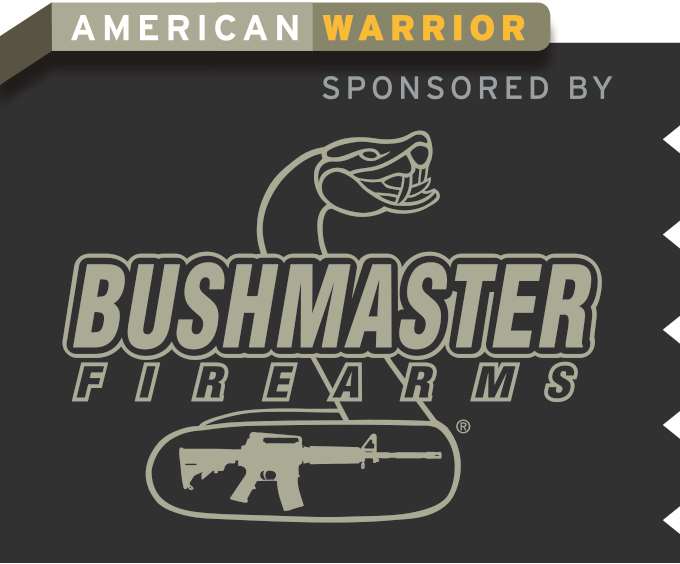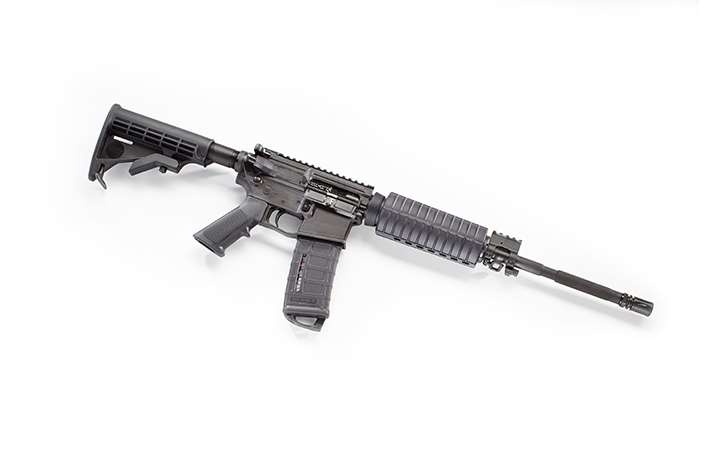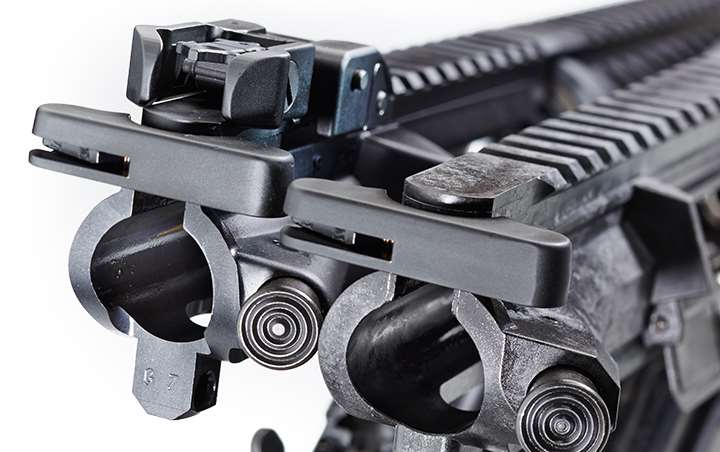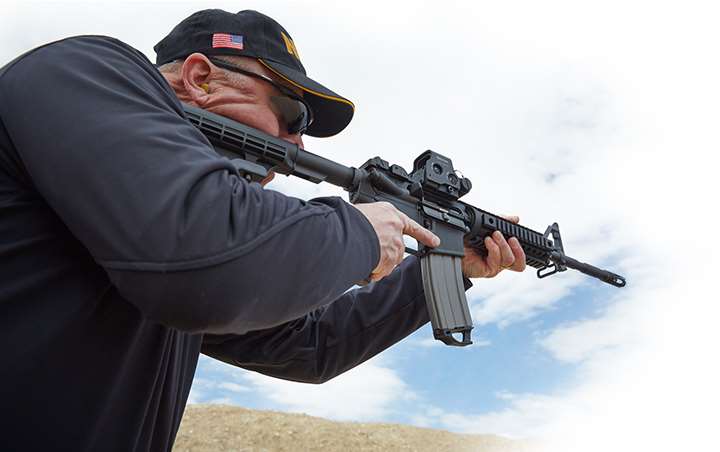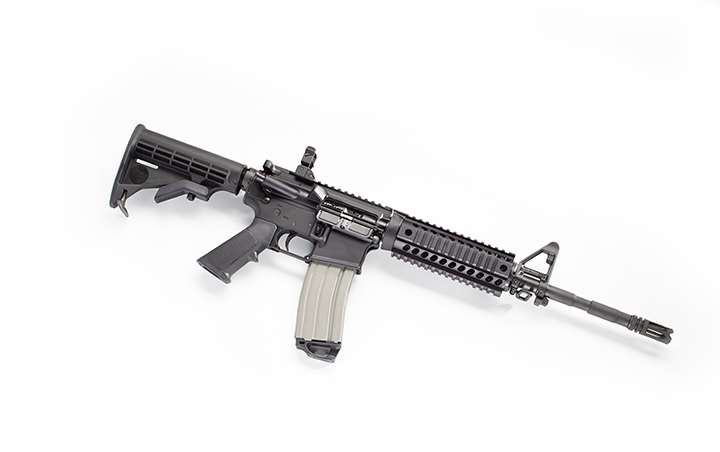
If it’s starting to look like we’re stuck in an AR rut, our reply would be, “What’s your point?”
True, a tremendous amount of information is already available. But much of the best data remains locked up in jargon, and widely, unhelpfully dispersed. We don’t offer ourselves as fit antagonists to a problem of such scale, but we’re determined to chip away where we can.
And we’ve had some spectacular help. Hopefully the “Fit For A Warrior” build series was useful for the nascent DIYers out there, but that’s hardly a solution that fits everyone. For many, “issue-only” duty restrictions make building an AR unfeasible except for personal use. That’s where Windham Weaponry enters the fray. Rising from the ashes, so to speak, of Bushmaster’s departure to Ilion, N.Y. (yes, that Ilion, home of Remington) in 2011, original Bushmaster owner Richard Dyke’s non-compete agreement expired almost simultaneously. Dyke’s Yankee determination, financing savvy, and loyal former employees had new rifles rolling down Roosevelt Trail again in only three months.
Two of them recently made a trip to Colorado.
A Tale of Two Materials
Carbon fiber and Stoner-pattern Ars have both been around for a while. Although not adopted until 1962, the initial design of the AR was complete in 1955. Carbon fiber technology emerged
shortly thereafter in the United States, Japan and the United Kingdom. As a world-class rifle, the aluminum-framed AR was secure by the 1970s. Carbon fiber took a while longer to carve a niche as a material of consequence, though the appeal was obvious from the start.
Roughly stated, carbon fibers are stiffer than both steel and aluminum (though only along the directions of the fibers). Even more impressive and useful is the relative density of carbon fiber: It’s slightly less than half the mass of aluminum, and nearly six times lighter than steel. Despite false starts and on-again, off-again success, those atom-aligned carbon filaments—composited with other materials based on application—now have literally thousands of uses, ranging from single fiber electrodes (one-sixth the diameter of a human hair) to aircraft wings. Somewhere in between are hundreds of rugged, lightweight firearms components, including grips, handguards, sleeved barrels, holsters and stocks—as well as our carbon fiber Windham Weaponry “SRC.”
Carry Me
A practiced eye will spot differences between the SRC and other ARs in short order. A difficult-to-describe matte finish replaces the smooth sheen of Mil-Spec anodizing on the upper and lower. “As molded” is the Windham description, and it’s by no means objectionable—you’ll just never confuse the two. Key structures are also thicker in the composite parts: Around both the takedown and pivot pin holes, for instance, as well as along the length of the wonderfully snug upper/ lower joint. Opening up the rifle—you will need a cartridge or other tool to press the pin through due to the reinforcement—also reveals thicker walls in the bolt carrier channel.
What you won’t see are a bunch of other specialized parts. Trigger, selector, magazine and bolt release are all standard, meaning if you want to replace components in a CF SRC, you won’t have any trouble. And that’s not meant to be a hint about that (gorgeous!) Geissele trigger for sale on the Windham website. Really. We mean it.
The remainder of the SRC configuration is familiar. The flattop upper has an unsighted Picatinny rail, properly slotted, but without “T” callouts. A 7-inch round carbine handguard covers the barrel up to the gas block. Again, there’s no sight, but Picatinny slots above, sling loop and bayonet lug below. In a continuing authenticity touch we find amusing but peculiar—and extending well beyond just the folks at Windham—the barrel is conveniently notched to mount your M203 grenade launcher. The 16-inch M4 profile, 1-in-9 twist, chrome-lined, chrome-moly vanadium steel barrel is finished with an A2 flash suppressor.
The lower is similar: There are no surprises in grip and six-position carbine stock, although we do like the larger, molded trigger guard. You should be good to go in gloves with it.
What will strike you when you stop looking at the Carbon Fiber SRC and pick it up is what a joy to carry it will be. With a JPoint or similar sight, you’ll just barely top 6 pounds.
Kick Butt With Me
As much as we like the materials science in the Carbon Fiber SRC, when we got around to the more-conventional forged aluminum uppered/lowered MPC14-RF-MFT, we wondered: Is there such a thing as a tough- guy nuance? Because if there is, this LE-spec’ed rifle has it: Mission First Tactical quad rail, Yankee Hill Machine “Phantom” flash suppressor or ACS Diamondhead flip-up BUS. Whatever, we want one.
A standard six-position carbine stock, trigger guard and grip complete the bottom and back of the rifle. The barrel is essentially the same as the Carbon Fiber rifle, but shortened to 14.5 inches for greater maneuverability and the YHM permanently attached to make length (16.1 inches, avoiding NFA entanglements).
Simply put, add an optic and you’re ready for work. Or don’t add one: We found the Diamondhead flip-up and conventional front post to be an uncommonly natural “pointer.”
Run 'Em
The first good day —and it wasn’t very good (think March in the Rockies)—we took both rifles to the range. First up was the LE MFT for a 100-yard test of the Diamondhead rear sight paired with the A2 front. Suffice it to say performance was admirable, even very admirable. While groups moved around on our half-sized MGM silhouette depending on manufacturer and bullet weight of ammunition, it was easy to keep shots on the target. We didn’t shoot for groups in the conventional sense as atmospheric conditions were just too variable, although the MPC-14 iron sights were up to putting consecutive shots on the 4-inch head of this target with regularity.
Next, we put an 8-minute-dot JPoint from JP Enterprises on the “bald” Carbon Fiber SRC. Thanks to dumb luck it was right on virtually from the start. Arguably, this dot was a little big given our target, but after a few adjustments—ding, ding, ding. With a 4-minute JP, this would be a packable delight.
Moving out to 200 yards allowed the wind to play more in our game. A few misses cropped up, but we have to own these. A Brownells EOTech CQB T-Dot fitted in turn on each rifle took care of the 200-yard issues in short order. We would have liked lighter triggers, but the very clean “break” on both helped a good deal.
We had a second range trip with both Windhams, and a chance to duck the wind in a narrow berm. With three MGM TAC BCCZ targets at ranges of 25, 30 and 35 yards, we went to—ahem—work? All right, so it wasn’t really “work.” Take a look at the videos (above left).
In both cases, the mechanical functioning of the rifles was flawless. As for the shooting results, well, we credit the rifles. A couple of interesting things did emerge, however.
As much as we liked the ACS Diamondhead at distance, we found it even more to our taste up close. From a safety-on, low ready position using the large aperture, we could repeatedly put single shots on three spread targets out to 35 yards in under two seconds, and had a couple of runs under 1.8 seconds with solid CoM hits. With the Brownells/ EOTech on the SRC, we ran even faster: For the same array, distances and start position, times edged perilously close to 1.5 seconds.
The clean break of both triggers helped here too, but the thought of a lighter spring set grew even more tantalizing.
One minor issue emerged, and it was slightly worse on the SRC: We had missed the modest but clever molded-in magwell flare on first inspection, but thought it well done. And it was, as we reloaded; the worry is on the way out. We tried two different brands and three different styles of polymer magazine and experienced slightly retarded mag exit frequently with one type. After experimenting with multiple mags and several other lowers, we decided it’s mostly the magazine. But check yours: Since we had no hint of a hang-up with multiple metal magazines, we at least suspect a polymer-on-polymer contribution.
A final plus: If you train new AR shooters, think seriously about adding a Windham SRC to your armory. With a quality set of polymer notch-and-post, or a reflex sight like our JPoint, AR novices will notice the easy handling of this sub 6-pound rifle immediately.
Was There A Break-In?
You may note we’ve said nothing about barrel break-in as we have in the past: Both our Windham rifles had chrome-lined bores. If you find a manufacturer who will sell you either a chrome-lined or unlined bore on the same rifle, the former is always more costly. The justification is not only an added manufacturing process, but also that your barrel will last longer—often substantially longer (5000-10,000 rounds (unlined) vs. 20,000 or more if chromed). Other experts meanwhile assert that chrome-lining is never acceptable because it compromises accuracy.
So who or what is correct? Unhelpfully, both.
The process of chrome-lining was first used in military machinegun barrels. Under battlefield conditions, the high heat—many thousands of degrees—and pressures could wear barrels in these weapons out in as little as 1,000 rounds. The advent of issue semi-automatics confirmed that semi-autos too could “shoot out” their traditional chrome-moly steel barrels in a hurry. Chrome-lining could vastly lengthen barrel life.
As the saying goes: “...and that’s how the fight started.” Accuracy fanatics rightly asserted that both the variability of chrome depth, and the differential heating of the chrome compared to nearby steel made these barrels uselessly inaccurate except in crew-served weapon applications. Their individual arm counterparts, quite the contrary: A military simply couldn’t run on rifles that might shoot through their barrels in a single desperate firefight.
The passage of time has helped tamp down disagreement. Chrome-lined barrels are better than they used to be: Both the underlying barrel-making process and materials are more precise, as is the chroming process itself. Improved metallurgy also means conventional and stainless steel barrels are better and “tougher” too.
The up-shot is the prospective application of your rifle: If ultimate precision is the likely task, the 1⁄4 to 1⁄2 MOA you lose with chrome may be a problem. If you’ll have to go tactical—no cool-down for that barrel for three, four, five magazines, even occasionally— chrome lining is worth every penny, and the accuracy downgrade meaningless.
So wither break-in? One thing most folks do agree on is that a chrome-lined bore needs no break-in: The chrome lining is so hard (relative to the surface of a copper-jacketed bullet) that no break-in can occur.
You might as well try to scrub your way out of Alcatraz with a cotton ball.
Gripes
Our list is short for both our Windham samples, a fine reflection on the folks in Maine. It’s also, perhaps, why they offer one of the best warranties in our business—lifetime, and transferable. That’s impressive in our minds, especially when you consider the very reasonable MSRPs of both.
For the SRC rifle, be cautious with non-metal bodied magazines. If your training/doctrine/ experience have you actively yanking the magazine out, you’re good to go. Just keep in mind that there may be times when you have to count on a mag “dropping” free—if injured, for instance, or in some tight-quarters positions. Not, we’d suggest, the time for a test.
Does this mean you shouldn’t use a polymer magazine in the SRC? By no means. And this would be a much greater worry if there weren’t plenty of metal-body options. It’s likely, in fact, that as the surfaces inside of the magwell and outside of magazines slick up through wear, all will drop speedily free. Keep in mind, however, that this could take considerable time: By design, both materials are mighty tough.
Our point is mainly that the SRC far too good a rifle to be undone by this 100 percent preventable mischance.
The LE MPC was a treat in almost every respect, and our gripes here are even less substantial. We think all quad rail handguards should come with rail covers. Call it wisdom, preference or just plain fussiness: We have a laundry list of reasons why, but enough said.
Not really a gripe, but we’d get a lighter trigger spring set in either rifle; nothing crazy, but 4.5-5.0 (down from ~7.0 pounds)? This would be enough to reveal the genuine accuracy potential of both rifles, and capitalize on what already feel like excellent engagement surfaces.
Final Analysis
We haven't had as much pure fun in a review/test in quite a while. Both the traditional aluminum and carbon fiber-based rifles performed very well in a sensible "envelope." Chrome-lining of the bores and barrel lengths mean thy were never intended to be long-range tack-drives, and we consequently didn't test them in such a venue. But at 200 yards we got no hint of accuracy problems, either: In fact, quite the opposite. With selected ammunition in appropriate bullet weights, we expect both are 1.5 MOA-capable or better, given good trigger manipulation, the excellent fit, and practice, practice, practice.
Another pleasing aspect is the fine reliability of both rifles: Not a single failure of feed or function was experienced with multiple ammunition types and magazines, though remember our one caveat regarding the SRC and polymer magazines. Test yours to confirm they fall free.
What, then, of our hypothetical AR rut? If we’re in one—and we probably are—it’s certainly proving educational for us, and perhaps for you too. What we’ve gained from our Windham examples as we bump along are certainly good lessons about materials, about craftsmanship, and about another time-honored, very “Yankee” notion—that of value.
If you need a personal or professional AR, you won’t be doing yourself any favors by dismissing a suitable Windham—you can be sure we won’t.
